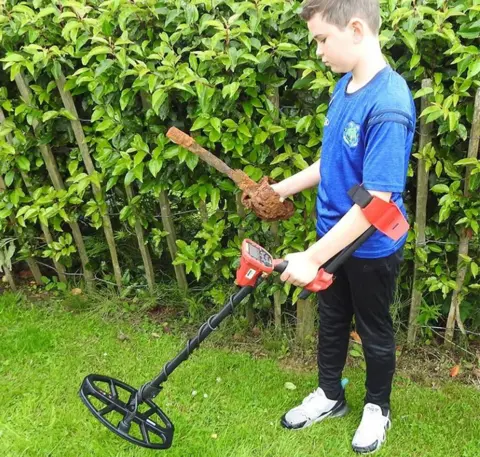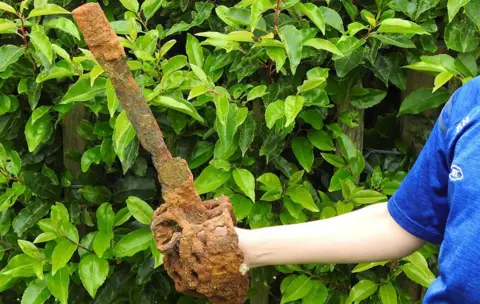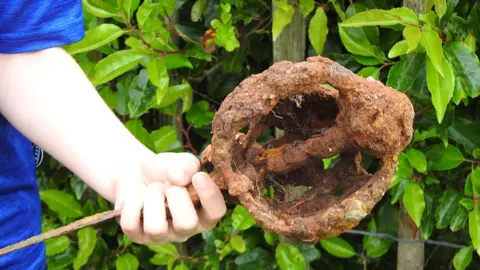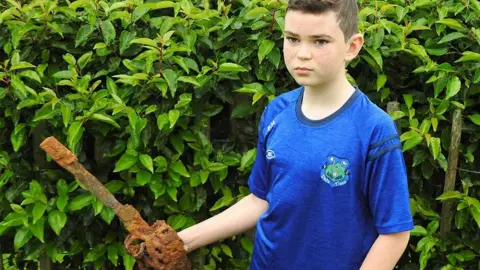Beginner's luck for 10-year-old metal detectorist
 Brian Quinn/Clonoe Gallery
Brian Quinn/Clonoe GalleryA schoolboy who got a metal detector for his 10th birthday struck lucky the first day he used it by finding a sword thought to be about 300 years old.
Fionntan Hughes, from Derrylaughan in County Tyrone, found the sword buried on land near his home late last month.
His father, Paul Hughes, was with him at the time and described the discovery as a case of "beginner's luck".
The family do not yet know the sword's exact age or its origin but are hoping a museum will take an interest in it.
Several antique arms dealerships have examined photos of the artefact and most of them estimate that it dates back to, or around, the 18th Century (1700-1799).
 Brian Quinn/Clonoe Gallery
Brian Quinn/Clonoe GalleryMr Hughes told BBC News NI he had no idea how old it was but he was keen to get it into the hands of experts so he could find out more about its provenance.
He explained that Fionntan had been asking for a metal detector for some time, so they decided to buy one for his 10th birthday last month.
The evening of Wednesday 29 July was the first opportunity they had as a family to try out his new present, so father and son went detecting with their cousin Darran Hanna on land near their home.
Fionntan's detector signalled twice earlier that evening but Mr Hughes said both objects turned out to be insignificant "trinkets".
The third signal, however, led the schoolboy to uncover the rusted weapon buried only about 1ft (30cm) below ground.
"I didn't know what it was until it was cleaned up," Fionntan said.
The schoolboy added he felt "quite excited" when he realised it was a sword.
'Plum pudding pommel'
Confirming its age has proved difficult due to its condition, but estimates from several sword dealers and military historians range from the late 17th Century right up to the early 19th Century.
"What a fine thing to find," said Philip Spooner, who has been an antique arms dealer for more than 30 years.
"The sword is basket hilt-type sword as used by English officers and dragoons from about 1720 to 1780, or it could be a Scottish basket hilt of about 1700 to 1850."
Mr Spooner added he felt it was "most likely an English officer's sword", due to its ornate design.
 Brian Quinn/Clonoe Gallery
Brian Quinn/Clonoe GalleryBrothers Mark and David Hawkins, who have more than 55 years experience in the antiques trade between them, explained it was difficult to assess the sword from photos, due to its condition.
"All that thick, rusty mud might easily be exaggerating the shape and size of everything," they said.
"We think it is likely an English basket-hilted broadsword, with flattened bars and large, plum pudding pommel - typical of the early types."
The brothers said this particular design began to appear from 1610 onwards, to about 1640.
However, as some design patterns were in use for more than 100 years, they said they believed this sword most likely dates from the "late 17th to the early 18th Century".
Mr Hughes said he now needed advice on how to preserve the artefact which he fears is "deteriorating by the day".
"The last thing I want is for it to be left rusting away in my garage," he said, adding he would prefer it to be in the hands of experts or on public display.
 Brian Quinn/Clonoe Gallery
Brian Quinn/Clonoe GalleryHe has reported the discovery to Dr Greer Ramsey, curator of archaeology at National Museums NI, who is in the process of determining its age and type.
There is no tradition of metal detecting in the Hughes family, but a few years ago Fionntan had shown an interest in the hobby so they bought him a cheap detector which was little more than a "toy".
For his 10th birthday, they "decided to invest" in more expensive equipment.
After what turned into a very productive first outing, Mr Hughes laughed that the investment "appears to have paid off already".
Fionntan said he wasn't sure what should happen to the sword next but he hoped it might be worth "some money".
For now though, he can't wait to go metal detecting again so he can look for more buried treasures.
